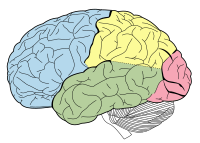
Photo from wikipedia
Seizures are a major cause of morbidity in patients with GBM, resulting in neurocognitive deficits and reduced QOL. There are limited studies on the predictors of postoperative seizures in these… Click to show full abstract
Seizures are a major cause of morbidity in patients with GBM, resulting in neurocognitive deficits and reduced QOL. There are limited studies on the predictors of postoperative seizures in these patients. Furthermore, there is no consensus among neurosurgeons on the timing of perioperative use of antiepileptic drugs (AEDs). The objective of this study is to determine patient- and tumor-related factors associated with postoperative seizures in GBM patients who undergo surgical resection. Our patient data registry was queried for adult patients treated for GBM at VCU from 2005 to 2014. Univariate and multivariable logistic regression analyses were performed to identify patient and tumor factors associated with postoperative seizure within a 12 month period. Cox proportional hazards regression analysis was used to evaluate the overall risk of postoperative seizure. 146 patients met the criteria for the study. Of these, 39 patients (27%) experienced a postoperative seizure within 12 months. On univariate analysis, factors significantly associated with postoperative seizure within 12-months included percent (%) of FLAIR volume resected (OR: .81; CI: 0.65-0.99; p=.046), history of AED use (OR: 2.51; CI: 1.20-5.25; p = 0.015), and history of seizure (OR: 2.26, CI: 1.07-4.76; p=0.033). On multivariate analysis, % FLAIR resection maintained significance. (OR of 0.79; CI: .63-.99; p = 0.044). The increased overall risk of postoperative seizure was associated with preoperative seizure < 30 days before surgery. (HR:6.65, CI: 1.02-43.36, p=0.048). Our study found that the increased extent of resection of FLAIR volume correlates with decreased odds of seizure occurrence in the 12-month postoperative period. Epileptogenesis of GBM seizures within this time period may be due to tumor-related edema or infiltrative tumor cells. Evaluation of FLAIR imaging postoperatively may be a useful clinical tool to guide AED management in high-risk patients.
Journal Title: Neuro-oncology
Year Published: 2020
Link to full text (if available)
Share on Social Media: Sign Up to like & get
recommendations!